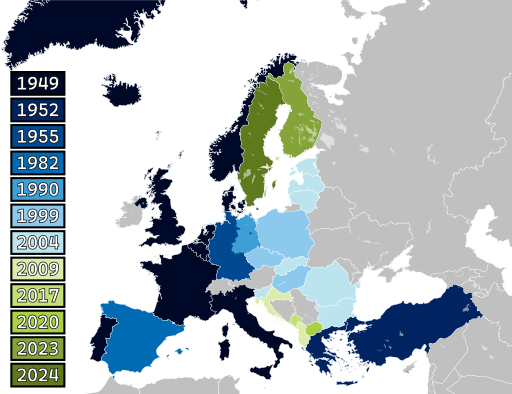NATO history and role
NATO, as a collective security system, is based on the mutual commitment of its member states to defend each other against any external threats.

NATO (North Atlantic Treaty Organization), or the North Atlantic Treaty Organization, was founded in 1949, with the main objective the common defense of member states against any external armed attack.
NATO aims to ensure the freedom and security of member countries through both political and military means.
NATO’s main headquarters is based in Brussels, Belgium, while the military headquarters is located near Mons, also in Belgium.
Politically, NATO is distinguished by the promotion of democratic values and the facilitation of consultation and collaboration among its members in defense and security matters. This approach aims to solve problems, build mutual trust and, in the long run, prevent conflict.
On the military side, NATO is committed to resolving disputes peacefully. However, in the event that diplomatic efforts do not achieve the desired goal, the Alliance has the military capability to undertake crisis management operations. These operations are conducted under the collective defense clause found in NATO’s founding treaty, known as Article 5 of the Washington Treaty, or under mandate from the United Nations. Such actions may be carried out independently or in cooperation with other international organizations.
Scenarios for a ‘new normal’ in geopolitics
History and Current Role
NATO was born in a Cold War context, as a response to the threat of Soviet expansion in Europe. During this period, the Alliance played a key role in ensuring the security and stability of the continent, with an emphasis on military deterrence. After the end of the Cold War, NATO adapted its role, expanding its scope to include peacekeeping, counterterrorism and crisis management operations.
Currently, NATO has 32 members, mainly European and North American countries. These members pledge to consult and defend each other in the event of an armed attack. In addition, NATO provides a forum for political and military cooperation among its members, promoting stability and security around the world.
The last countries to join NATO were Finland (2023) and Sweden (2024) who joined following the Russia-Ukraine conflict that began in February 2022.
Non-NATO Countries
Despite NATO’s influence and importance, some European countries have chosen not to join the alliance, opting instead for policies of neutrality. Among the most notable are Austria, Ireland and Switzerland.
Neutrality has traditionally been seen as a way to avoid international conflict and maintain a position of non-alignment. These countries have chosen not to participate in military alliances such as NATO, preferring to maintain a position of independence and non-involvement in armed conflicts.
The Implications of Neutrality
The choice to remain neutral has a number of political, economic, and security implications. On the one hand, neutral countries may enjoy greater decision-making autonomy and relative independence in international relations. On the other, they may be subject to external pressures from regional or global powers seeking to influence their foreign policies.
In terms of security, neutral countries must rely primarily on their own armed forces and diplomacy to ensure their defense.
List of NATO member countries and year of accession (in alphabetical order)
- ALBANIA (2009)
- BELGIUM (1949)
- BULGARIA (2004)
- CANADA (1949)
- CZECHIA (1999)
- CROATIA (2009)
- DENMARK (1949)
- ESTONIA (2004)
- FINLAND (2023)
- FRANCE (1949)
- GERMANY (1955)
- GREECE (1952)
- ICELAND (1949)
- ITALY (1949)
- LATVIA (2004)
- LITHUANIA (2004)
- LUXEMBOURG (1949)
- NORTHERN MACEDONIA (2020)
- MONTENEGRO (2017)
- NORWAY (1949)
- NETHERLANDS (1949)
- POLAND (1999)
- PORTUGAL (1949)
- UNITED KINGDOM (1949)
- ROMANIA (2004)
- SLOVAKIA (2004)
- SLOVENIA (2004)
- SPAIN (1982)
- UNITED STATES (1949)
- SWEDEN (2024)
- TURKEY (1952)
- HUNGARY (1999)
Similar Organizations
The Collective Security Treaty Organization (OTSC) established in 1992 founded by post-Soviet states (Russia, Armenia, Kazakhstan, Kyrgyzstan, Tajikistan and Uzbekistan) signed the Collective Security Treaty in the city of Tashkent, also known as the Tashkent Pact or Treaty of Tashkent. Azerbaijan, Belarus and Georgia, joined this organization in 1993.
The OTSC was to last for an extendable 5-year period, but in 1999 Azerbaijan, Georgia and Uzbekistan, chose not to renew the treaty.
The OTSC can be considered the Eurasian counterpart of NATO, i.e., a reissue of the Warsaw Pact adapted to changing times.





